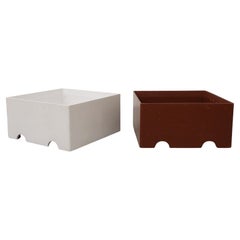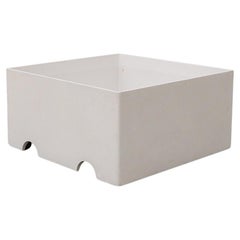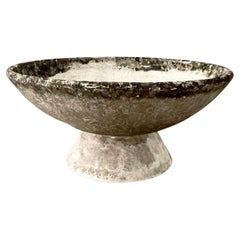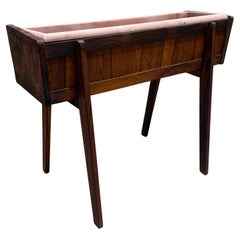Kartell Planters and Jardinieres
The Italian design giant Kartell transformed plastic from the stuff of humble household goods into a staple of luxury design in the 1960s. Founded in Milan by Italian chemical engineer Giulio Castelli (1920–2006) and his wife Anna Ferrieri (1918–2006), Kartell began as an industrial design firm, producing useful items like ski racks for automobiles and laboratory equipment designed to replace breakable glass with sturdy plastic. Even as companies like Olivetti and Vespa were making Italian design popular in the 1950s, typewriters and scooters were relatively costly, and Castelli and Ferrieri wanted to provide Italian consumers with affordable, stylish goods.
They launched a housewares division of Kartell in 1953, making lighting fixtures and kitchen tools and accessories from colorful molded plastic. Consumers in the postwar era were initially skeptical of plastic goods, but their affordability and infinite range of styles and hues eventually won devotees. Tupperware parties in the United States made plastic storage containers ubiquitous in postwar homes, and Kartell’s ingenious designs for juicers, dustpans, and dish racks conquered Europe. Kartell designer Gino Colombini was responsible for many of these early products, and his design for the KS 1146 Bucket won the Compasso d’Oro prize in 1955.
Buoyed by its success in the home goods market, Kartell introduced its Habitat division in 1963. Designers Marco Zanuso and Richard Sapper created the K1340 (later called the K 4999) children’s chair that year, and families enjoyed their bright colors and light weight, which made them easy for kids to pick up and move. In 1965, Joe Colombo (1924–78) created one of Kartell’s few pieces of non-plastic furniture, the 4801 chair, which sits low to the ground and comprised of just three curved pieces of plywood. (In 2012, Kartell reissued the chair in plastic.) Colombo followed up on the success of the 4801 with the iconic 4867 Universal Chair in 1967, which, like Verner Panton’s S chair, is made from a single piece of plastic. The colorful, stackable injection-molded chair was an instant classic. That same year, Kartell introduced Colombo’s KD27 table lamp. Ferrierei’s cylindrical 4966 Componibili storage module debuted in 1969.
Kartell achieved international recognition for its innovative work in 1972, when a landmark exhibition curated by Emilio Ambasz called “Italy: The New Domestic Landscape” opened at New York’s Museum of Modern Art. That show introduced American audiences to the work of designers such as Gaetano Pesce; Ettore Sottsass, founder of the Memphis Group; and the firms Archizoom and Superstudio (both firms were among Italy's Radical design groups) — all of whom were using wit, humor and unorthodox materials to create a bracingly original interior aesthetic.
Castelli and Ferrieri sold Kartell to Claudio Luti, their son-in-law, in 1988, and since then, Luti has expanded the company’s roster of designers.
Kartell produced Ron Arad’s Bookworm wall shelf in 1994, and Philippe Starck’s La Marie chair in 1998. More recently, Kartell has collaborated with the Japanese collective Nendo, Spanish architect Patricia Urquiola and glass designer Tokujin Yoshioka, among many others. Kartell classics can be found in museums around the world, including MoMA, the Victoria and Albert Museum and the Cooper Hewitt, Smithsonian Design Museum. In 1999, Claudio Luti established the Museo Kartell to tell the company’s story, through key objects from its innovative and colorful history.
Find vintage Kartell tables, seating, table lamps and other furniture on 1stDibs.
1980s Italian Mid-Century Modern Vintage Kartell Planters and Jardinieres
Plastic
1980s Italian Mid-Century Modern Vintage Kartell Planters and Jardinieres
Plastic
Mid-20th Century Swiss Mid-Century Modern Kartell Planters and Jardinieres
Concrete
1960s Danish Scandinavian Modern Vintage Kartell Planters and Jardinieres
Rosewood
20th Century American Kartell Planters and Jardinieres
Wrought Iron
Mid-20th Century Swiss Mid-Century Modern Kartell Planters and Jardinieres
Concrete
Mid-20th Century British Mid-Century Modern Kartell Planters and Jardinieres
Ceramic
1950s French Mid-Century Modern Vintage Kartell Planters and Jardinieres
Cement
1960s Swiss Mid-Century Modern Vintage Kartell Planters and Jardinieres
Cement
1960s Swiss Vintage Kartell Planters and Jardinieres
Concrete
1980s Vintage Kartell Planters and Jardinieres
Aluminum
1920s Chinese Chinese Export Vintage Kartell Planters and Jardinieres
Porcelain
Mid-20th Century French Mid-Century Modern Kartell Planters and Jardinieres
Ceramic
1970s Italian Vintage Kartell Planters and Jardinieres
Rush, Mirror
Kartell planters and jardinieres for sale on 1stDibs.
- Who is the founder of Kartell?1 Answer1stDibs ExpertOctober 15, 2024The founders of Kartell are Italian chemical engineer Giulio Castelli and his wife, Anna Ferrieri. Kartell began as an industrial design firm, producing useful items like ski racks for automobiles and laboratory equipment designed to replace breakable glass with sturdy plastic. Even as companies like Olivetti and Vespa made Italian design popular in the 1950s, typewriters and scooters were relatively costly. Castelli and Ferrieri wanted to provide Italian consumers with affordable, stylish goods. They launched a housewares division of Kartell in 1953, making lighting fixtures, kitchen tools and accessories from colorful molded plastic. Buoyed by its success in the home goods market, Kartell introduced its Habitat division in 1963. Castelli and Ferrieri sold Kartell to Claudio Luti, their son-in-law, in 1988, and since then, Luti has expanded the company’s roster of designers. Shop a collection of Kartell furniture on 1stDibs.
- Where is Kartell made?1 Answer1stDibs ExpertOctober 24, 2024Kartell is made in Italy. The company has had its headquarters and factory in Noviglio, Lombardy, since 1967. The company was initially founded in Milan by Italian chemical engineer Giulio Castelli and his wife, Anna Ferrieri. It began as an industrial design firm, producing useful items like ski racks for automobiles and laboratory equipment designed to replace breakable glass with sturdy plastic. Shop a wide variety of Kartell furniture on 1stDibs.
- What is Kartell known for?1 Answer1stDibs ExpertMarch 22, 2022Kartell is known largely for producing contemporary furniture out of plastic. The Italian company, founded in 1949, helped elevate the material, proving that it was suitable for designer furniture. You can find a collection of Kartell furniture and decorative objects on 1stDibs.
- What is the history of Kartell?1 Answer1stDibs ExpertFebruary 21, 2024The history of Kartell starts with an Italian chemical engineer named Giulio Castelli and his wife, Anna Ferrieri. The couple founded Kartell in Milan as an industrial design firm, producing utilitarian items like ski racks for automobiles and laboratory equipment designed to replace breakable glass with sturdy plastic. Even as companies like Olivetti and Vespa were making Italian design popular in the 1950s, typewriters and scooters were relatively costly, and Castelli and Ferrieri wanted to provide Italian consumers with affordable, stylish goods. They launched a housewares division of Kartell in 1953, making lighting fixtures and kitchen tools and accessories from colorful molded plastic. Buoyed by its success in the home goods market, Kartell introduced its Habitat division in 1963. Kartell achieved international recognition for its innovative work in 1972, when a landmark exhibition curated by Emilio Ambasz called "Italy: The New Domestic Landscape" opened at New York's Museum of Modern Art. Castelli and Ferrieri sold Kartell to Claudio Luti, their son-in-law, in 1988, and since then, Luti has expanded the company's roster of designers. On 1stDibs, explore a large selection of Kartell furniture.
- What country is Kartell from?1 Answer1stDibs ExpertAugust 29, 2024The country that Kartell is from is Italy. Founded in Milan by Italian chemical engineer Giulio Castelli and his wife Anna Ferrieri, Kartell began as an industrial design firm, producing useful items like ski racks for automobiles and laboratory equipment designed to replace breakable glass with sturdy plastic. They launched a housewares division of Kartell in 1953, making lighting fixtures and kitchen tools and accessories from colorful molded plastic. Then, buoyed by its success in the home goods market, Kartell introduced its Habitat division in 1963. On 1stDibs, shop a large selection of Kartel furniture.
- How do you tell a real Kartell?1 Answer1stDibs ExpertOctober 15, 2024To tell a real Kartell, look for the maker's markings. Nearly all authentic pieces will feature an embossed mark that indicates the Kartell name, the product name and the designer name. If your piece lacks any of these three marks or the marking is printed in ink on the piece or on a paper label, it may be a replica. You can also research identifying characteristics for your particular type of furniture and use these to evaluate your item. Alternatively, you can seek the opinion of a certified appraiser or knowledgeable dealer. Find a variety of Kartell furniture on 1stDibs.
- Where are Kartell chairs made?1 Answer1stDibs ExpertOctober 24, 2024Kartell chairs are made in Italy. Since 1967, the Italian furniture maker has produced pieces at its own factory in Noviglio, Lombardy. During the 1960s, Kartell transformed plastic from the stuff of humble household goods into a staple of luxury design, and plastic remains one of its best-known materials to this day. In fact, it is the material for some of its most iconic chairs, including the Ghost chair, designed by Philippe Starck, and the S chair, created by Verner Panton. On 1stDibs, find a large collection of Kartell chairs.
- 1stDibs ExpertOctober 24, 2024The history of Kartell furniture begins with Italian chemical engineer Giulio Castelli and his wife, Anna Ferrieri. They founded the company in 1949 as an industrial design firm, producing items like ski racks for automobiles and laboratory equipment designed to replace breakable glass with sturdy plastic. They launched a housewares division of Kartell in 1953, making lighting fixtures, kitchen tools and accessories from colorful molded plastic. The affordability and infinite range of styles and hues won devotees of Kartell’s ingenious designs for juicers, dustpans and dish racks. Kartell designer Gino Colombini was responsible for many of these early products, including the KS 1146 Bucket, which won the Compasso d’Oro prize in 1955. Buoyed by its success in the home goods market, Kartell introduced its Habitat division in 1963. In 1972, Kartell achieved international recognition for its innovative work when a landmark exhibition curated by Emilio Ambasz called “Italy: The New Domestic Landscape” opened at New York’s Museum of Modern Art. In 1988, Castelli and Ferrieri sold Kartell to Claudio Luti, their son-in-law, who has expanded the company’s roster of designers. Shop a collection of Kartell furniture on 1stDibs.
- 1stDibs ExpertMarch 25, 2024How you clean Kartell plastic depends on the piece. Often, the best way to clean plastic furniture is with lukewarm water and mild dish soap. However, recommended cleaning methods vary. For the best results, refer to the manufacturer's care instructions that accompany your furniture. Shop a collection of Kartell furniture on 1stDibs.
- Is Kartell an Italian brand?1 Answer1stDibs ExpertSeptember 9, 2024Yes, Kartell is an Italian brand. Giulio Castelli and his wife, Anna Ferrieri, founded the company in Milan in 1949. Originally, Kartell was an industrial design firm, producing items like ski racks for automobiles and laboratory equipment to replace breakable glass with sturdy plastic. It first introduced its housewares division in 1953. Find a large selection of Kartell furniture on 1stDibs.
- 1stDibs ExpertSeptember 9, 2024Yes, the Kartell Componibili is stackable. In fact, a big part of the appeal of the furniture collection is the fact that you can stack it up to create the ideal storage solution for your needs. Kartell first unveiled the Componibili line in 1967, and it remains popular today. Find a collection of Kartell Componibili furniture on 1stDibs.
- 1stDibs ExpertApril 5, 2022Kartell Louis Ghost chairs are made of lucite. Designed by Phillipe Starck for Kartell in 2002, this clear chair is crafted from a single piece of plastic, making it a beautifully elegant piece. On 1stDibs, find a range of authentic Kartell Ghost chairs from top sellers.
- 1stDibs ExpertAugust 20, 2024The dimensions of the Kartell Invisible table vary by style. The high rectangular table measures around 15.75 inches in height by 15.75 inches in depth by 47 inches in length, while the low rectangle version is 12.4 inches high by 15.75 inches deep by 47 inches long. There is also a 39-inch by 39-inch square Invisible table available in 28- and 12.4-inch heights. On 1stDibs, explore a selection of Kartell Invisible tables.
- 1stDibs ExpertOctober 24, 2024How big the Kartell Four table is varies. The rectangular dining table is actually available in four sizes. Its smallest version measures 62.5 inches in width by 31 inches in depth, and the largest is 87.5 inches long by 32 inches deep. Kartell also offers a 74.75-inch long option in two depths: 31 inches and 35.5 inches. All four size options are 28.25 inches tall. Shop a selection of Kartell dining tables on 1stDibs.
- 1stDibs ExpertOctober 15, 2024Yes, many online reviewers state that the Kartell Masters chair is comfortable. Fans of the chair designed by Philippe Starck with Eugeni Quitllet frequently say that the unique shape of its back and its gently sloped seat together provide optimal support. However, whether or not any chair is comfortable is a matter of personal preference. Find an assortment of Kartell Masters chairs on 1stDibs.
- 1stDibs ExpertOctober 24, 2024Kartell started making plastic objects shortly after its founding in 1949. The company began as an industrial design firm, producing useful items like ski racks for automobiles and laboratory equipment designed to replace breakable glass with sturdy plastic. Even as companies like Olivetti and Vespa made Italian design popular in the 1950s, typewriters and scooters remained relatively costly. Kartell founders Giulio Castelli and Anna Ferrieri wanted to provide Italian consumers with affordable, stylish goods. They launched a housewares division in 1953, making lighting fixtures, kitchen tools and accessories from colorful molded plastic. Buoyed by its success in the home goods market, Kartell introduced its Habitat division in 1963. On 1stDibs, shop a wide range of Kartell furniture.
- 1stDibs ExpertAugust 29, 2024Philippe Starck designed the Louis Ghost chair for Kartell in 2002. The chair is a postmodern take on the classic Louis XVI armchair, a style that emerged under the fraught reign of French King Louis XVI and Queen Marie Antoinette. This style represented the birth of neoclassicism in France and was characterized by a relative restraint compared to the Rococo flourishes of previous eras. The second half of the chair’s name refers to its materiality. It wasn’t Starck’s first plastic chair for Kartell, but it was the first time it could use a single polycarbonate plastic mold in the process, creating a structure completely free of joints. Formally, Starck distilled the geometry of his antique reference to its main elements: the oval-shaped backrest, curved armrests and straight legs. On 1stDibs, shop a collection of Philippe Starck Louis Ghost chairs.



